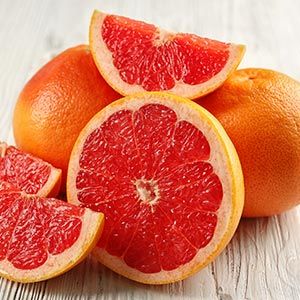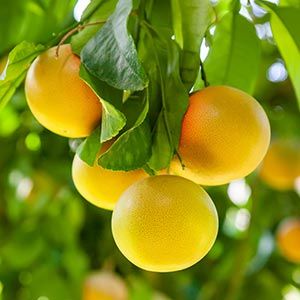Grapefruit: This Refreshing Fruit Is Packed With Antioxidants
Juicy, refreshing and rich in potent antioxidants, this member of the citrus family offers benefits to your pet’s health, if they’ll eat it, but make sure to serve it without the peel. Learn more about its benefits and how to offer it to pets here.

STORY AT-A-GLANCE
- Most dogs and cats won’t be interested in eating grapefruit, but it’s safe for them to consume, if they show an interest
- Offer grapefruit to your pets with the peel and seeds removed, portioned into bite-sized pieces that your pet can comfortably chew
- Naringin and naringenin are the primary bioactive polyphenols in citrus fruits; they exhibit anticancer properties and protective action against diabetes, neurodegeneration, metabolic syndrome and cardiovascular disorders
- Red grapefruits are considered one of the important sources of lycopene, which has antioxidant, antihypertensive, neuroprotective, cardioprotective and anti-inflammatory properties
Editor's Note: This article is a reprint. It was originally published April 14, 2023.
Grapefruit (Citrus × paradisi) is a fairly new addition to the citrus family, believed to have originated from the island of Barbados as a result of hybridization between a sweet orange and a pomelo.1,2 It’s one of the larger citrus fruits, with a diameter of 10 to 15 centimeters (4 to 6 inches). It has a thick, smooth rind that’s yellow or pink-blushed, with a red, pink or white flesh that tastes sweet, tart and mildly bitter.3,4 It grows in clusters on trees, similar to grapes, hence its name.5
Grapefruit is eaten peeled and raw, the same way you would eat an orange, clementine or any other citrus fruit. It can also be juiced or used in salads and sweet or savory dishes, as it pairs well with fish and pork.6 But can pets also enjoy this fruit and benefit from it the same way you do? Continue reading to find out.
Top U.S. Producers of Grapefruit

The U.S. is a principal exporter of grapefruit. Florida leads the production, harvesting 3.3 million boxes of grapefruit during the 2021 to 2022 season,7 while California and Texas came in at 2nd and 3rd place.8

The Lowdown on Grapefruit’s Safety for Pets
Misinformation about many healthy fruits, vegetables, nuts and seeds abounds on the internet. This is because websites have labeled all risks (such as the risk of overconsumption causing gastrointestinal issues, as is the case with grapefruit) as "toxicities," which isn't true but has managed to confuse millions of pet lovers, nonetheless.
In the case of grapefruit, there’s confusion among pet parents whether it’s safe to share with pets or not, as some websites say grapefruit is toxic to cats and dogs. However, there are no cited sources for the claims that the fruit is toxic. Grapefruit flesh has no published toxicity reports and can be safely offered to pets as a healthy snack, which constitutes less than 10% of your pet’s overall calories.
It’s the peel and other plant parts that contain essential oils, which can cause stomach discomfort and have been associated with adverse events. Hence, you can easily avoid adverse effects by offering your pet only the flesh of the grapefruit and making sure they don’t have access to any discarded peels or other plant parts.
“Offer grapefruit to your pets the same way you would eat it — with the peel and seeds removed, portioned into slices or bite-sized pieces that your pet can comfortably chew.”
Cats, in general, have an aversion to citrus fruits, but it’s safe to offer them a bite of peeled grapefruit if they’re interested in eating some. The citric acid in the flesh can cause loose stools when consumed in excess, so remember not to offer your pet too many slices.9,10 Relatedly, keep in mind that healthy treats like this should make up less than 10% of your pet’s daily caloric intake, and always start by offering only tiny amounts.
Dogs often aren’t interested in trying grapefruit, but if your dog is, always start with a piece that’s half the size of one paw, and make sure that it doesn’t cause loose stools. If your pup has no stool changes, you can slowly increase the amounts you offer.
Naringin and Naringenin: Anticancer Polyphenols in Grapefruit
Naringin and its aglycone form naringenin are the primary bioactive polyphenols in citrus fruits. Naringenin is particularly high in grapefruit extract at 43.5 milligrams per 100-milliliter serving.11 According to a study published in the journal Biomedicines:12
“Numerous studies have reported these substances’ antioxidant and antiandrogenic properties, as well as their ability to protect from inflammation and cancer, in various in vitro and in vivo experimental models in animals and humans.”
These compounds have been shown to interfere with cancer development and progression through various mechanisms of action, including “modulating several unregulated signaling pathways associated with inflammation, proliferation, apoptosis, autophagy, angiogenesis, invasion and metastasis.”13
In addition to their anticancer properties, naringin and naringenin have also been found to exhibit protective action against diabetes, neurodegeneration, metabolic syndrome and cardiovascular disorders.14,15
Red and Pink Grapefruits Provide Lycopene and Beta-Carotene
Lycopene is a type of carotenoid that exhibits powerful antioxidant properties. It’s found in red, pink and orange fruits and vegetables. Red grapefruits, in particular, are considered one of the important sources of this compound,16 although it’s also found in the pink varieties.17 In addition to the ability to fight free radicals, lycopene also exhibits antihypertensive, neuroprotective, cardioprotective and anti-inflammatory properties.18
Studies have also documented lycopene’s anticancer action. In a study published in the American Journal of Veterinary Research, researchers evaluated the effects of lycopene on the growth and death of canine osteosarcoma cells. Their findings showed lycopene alone helped cause “mild to pronounced” reduction in the proliferation of cancer cells, as well as apoptosis (cell death) in highly metastasizing canine osteosarcoma cell lines.19
Another powerful antioxidant carotenoid found in red and pink grapefruits is beta-carotene (provitamin A).20 A 100-gram serving of pink or red grapefruit provides 686 micrograms of this compound.21 Research has shown that beta-carotene may help improve canine immune responses, particularly in older dogs.22 Another study published in the Journal of Nutritional Science also found that beta-carotene helped improve retinal response and reduced age-related retinal and visual functional decline in dogs.23
Did You Know?

Red grapefruit gets its color from high amounts of lycopene,24 and research shows grapefruits grown in shade have a more intense red hue than those exposed to light.25
Other Beneficial Nutrients Found in Grapefruit
Another major bioactive compound found in grapefruit is hesperidin, which has antioxidant, anti-inflammatory, antiviral and anticancer properties, and may help protect against cardiovascular and neurodegenerative disorders.26 A study in Research in Veterinary Science noted hesperidin to be one of the “promising candidates to be considered in the treatment of CDV (canine distemper virus),” as it exhibited antiviral activity against it.27
Grapefruit is also rich in vitamin C, providing 31.2 milligrams per 100-gram servings.28 Although dogs can synthesize vitamin C in their body, getting supplementary amounts of this vitamin from their diet can be good for their health. Vitamin C is a powerful antioxidant, helping reduce inflammation and cognitive decline.29 It also plays an important role in the biosynthesis of collagen, L-carnitine and certain neurotransmitters.30
Is Growing Grapefruit Sustainable?

Grapefruit farming is considered sustainable, as it does not have significant impact to air, water, soil and other resources.31 In Florida, grapefruit growers have been using sustainable farming practices to reduce water usage, limit erosion and reduce pesticide use, such as using red kaolin clay to repel insects.32
With that said, grapefruit ranks No. 26 in the Environmental Working Group’s Shopper’s Guide to Pesticides in Produce™,33 which means that conventionally grown varieties may still have traces of pesticides even though they’re not the most heavily contaminated.
For this reason, opt to buy organic, spray-free grapefruit from your local farmers market as much as possible. If you only have conventionally grown grapefruit, wash it well before peeling.
How to Choose Grapefruit and Offer It to Your Pets
When choosing grapefruits for your family, aside from opting for organic whenever possible, you should also look for grapefruits that have a deeper color without green patches, as this indicates ripeness. Having an oval shape or a flat side is also an indicator that they’ve softened up and have become sweeter. They should also feel plump and heavy for their size, with a smooth rind that gives slightly but bounces back after you give it a gentle squeeze.34,35
As mentioned earlier, peel the rind of the grapefruit before serving it fresh to your pet as a snack or using it as an ingredient in a homemade training treat. You can put any leftover peeled sections in an airtight container and store it in the refrigerator.36
Pureed and frozen grapefruit can be a refreshing snack for pets too, especially during the warmer months. You can mix it with other mashed or soft foods (like plain yogurt and squash), and spread it on their lick mat — this also helps mask the tart flavor of the grapefruit, which some pets may find off-putting.
As with other fruits, grapefruit contains sugar, which can harm your pet’s health when consumed in excessive amounts, so remember not to give them too much of this fruit. Avoid giving your pet grapefruit-flavored food or drinks as well, as they’re often loaded with added sugars and high-fructose corn syrup.
Sources and References
- 1 John Hopkins Medicine, Grapefruit Benefits
- 2,3,5,6,36 The Spruce Eats, December 20, 2021
- 4 Science Direct, Anthocyanins and Other Polyphenols in Citrus Genus in Polyphenols in Plants (Second Edition), 2019
- 7 WUSF Public Media, December 10, 2022
- 8 USDA National Agricultural Statistics Service, Citrus
- 9 AKC, December 8, 2022
- 10 PetMD, December 14, 2022
- 11,15 Biomolecules 2019, 9(3), 99
- 12,13 Biomedicines. 2022 Jul; 10(7): 1686
- 14 Mini Reviews in Medicinal Chemistry, Volume 20, Number 4, 2020, pp. 286-293(8)
- 16,18 Oxid Med Cell Longev. 2021; 2021: 2713511
- 17,20 Food Nutr Res. 2014; 58: 10.3402/fnr.v58.22179
- 19 Am J Vet Res. 2010 Nov;71(11):1362-70
- 21,28 USDA FoodData Central, Grapefruit, raw, pink and red, all areas
- 22 J Vet Intern Med. 2003 Nov-Dec;17(6):835-42
- 23 J Nutr Sci. 2016; 5: e18
- 24 Science Direct, CITRUS FRUITS | Grapefruits in Nuts and Seeds in Health and Disease Prevention
- 25 Physiol Plant. 2015 Aug;154(4):469-84
- 26 Nutrients. 2022 Jun; 14(12): 2387
- 27 Research in Veterinary Science. Volume 95, Issue 2, October 2013, Pages 717-724
- 29 AKC, May 4, 2020
- 30 NIH ODS, Vitamin C
- 31 Healabel, January 2, 2023
- 32 Florida Citrus, Environmental Sustainability
- 33 EWG, Shopper's Guide to Pesticides in Produce™
- 34 Health Family Project, Grapefruit
- 35 US Citrus, November 20, 2020











